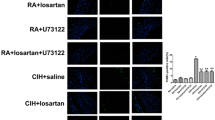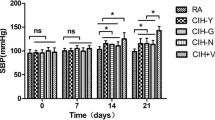Summary
The effects of nicotinamide adenine dinucleotide phosphate (NADPH) oxidase inhibitor apocynin on the enhanced hypoxia induced factor-1α (HIF-1α) and endothelin-1 (ET-1) expression, elevated systolic blood pressure under chronic intermittent hypoxia (CIH) condition and its action mechanism were investigated. Thirty healthy 8-week old Sprague-Dawley (SD) male rats were randomly divided into three groups (n=10 each): sham group, CIH group, and apocynin-treated CIH group. Tail artery systolic blood pressure was measured by tail-cuff method. Real-time fluorescence quantitative polymerase chain reaction (PCR) was used to detect the mRNA expression of HIF-1α and ET-1 in the carotid body, and the HIF-1α protein expression was examined by using Western blotting. The levels of malondialdehyde (MDA) and superoxide dismutase (SOD) were determined by using colorimetric method. In addition, the plasma ET-1 and HIF-1α levels were measured by using enzyme-linked immunosorbent assay. It was found that CIH exposure was associated with increased MDA levels, and apocynin-treated CIH animals showed reduction in MDA levels. Apocynin treatment prevented CIH-induced hypertension as well as CIH-induced decrease in SOD. The increases of HIF-1α and ET-1 mRNA along with HIF-1α protein expression in the carotid body, and elevated circulating HIF-1α and ET-1 levels were observed in CIH-exposed animals. Treatment with apocynin significantly decreased the ET-1 mRNA, HIF-1α protein expression and circulating HIF-1α level in CIH-exposed animals, and there was no statistically significant difference in the HIF-1α mRNA expression between CIH group and apocynin-treated group. These results indicated that apocynin alleviated CIH-induced hypertension by inhibiting NADPH oxidase, further leading to the reduced vasoconstrictor ET-1 level and oxidative stress. HIF-1α/ET-1 system signal pathway may interact with CIH-induced NADPH oxidase-dependent oxidative stress. Inhibition of NADPH oxidase activity may hopefully serve as a useful strategy for prevention and treatment of obstructive sleep apnea hypopnea syndrome-induced hypertension.
Similar content being viewed by others
References
Budhiraja R, Quan SF. Sleep-disordered breathing and cardiovascular health. Curr Opin Pulm Med, 2005,11(6):501–506
Quan SF, Gersh BJ. Cardiovascular consequences of sleep-disordered breathing: past, present and future: report of a workshop from the National Center on Sleep Disorders Research and the National Heart, Lung, and Blood Institute. Circulation, 2004,109(8):951–957
Young T, Palta M, Dempsey J, et al. The occurrence of sleep-disordered breathing among middle-aged adults. N Engl J Med, 1993,328(17):1230–1235
Millman RP, Redline S, Carlisle CC, et al. Daytime hypertension in obstructive sleep apnea. Prevalence and contributing risk factors. Chest, 1991,99(4):861–866
Haas DC, Foster GL, Nieto FJ, et al. Age-dependent associations between sleep-disordered breathing and hypertension: importance of discriminating between systolic/diastolic hypertension and isolated systolic hypertension in the Sleep Heart Health Study. Circulation, 2005,111(5):614–621
Jordan W, Cohrs S, Degner D, et al. Evaluation of oxidative stress measurements in obstructive sleep apnea syndrome. J Neural Transm, 2006,113(2):239–254
Levy P, Tamisier R, Arnaud C, et al. Sleep deprivation, sleep apnea and cardiovascular diseases. Front Biosci (Elite Ed), 2012,4(1):2007–2021
Phillips BG, Narkiewicz K, Pesek CA, et al. Effects of obstructive sleep apnea on endothelin-1 and blood pressure. J Hypertens, 1999,17(1):61–66
Jordan W, Reinbacher A, Cohrs S, et al. Obstructive sleep apnea: Plasma endothelin-1 precursor but not endothelin-1 levels are elevated and decline with nasal continuous positive airway pressure. Peptides, 2005,26(9):1654–1660
Gjorup PH, Sadauskiene L, Wessels J, et al. Abnormally increased endothelin-1 in plasma during the night in obstructive sleep apnea: relation to blood pressure and severity of disease. Am J Hypertens, 2007,20(1):44–52
Kanagy NL, Walker BR, Nelin LD. Role of endothelin in intermittent hypoxia-induced hypertension. Hypertension, 2001,37(2 part 2):511–515
Troncoso Brindeiro CM, da Silva AQ, Allahdadi KJ, et al. Reactive oxygen species contribute to sleep apnea-induced hypertension in rats. Am J Physiol Heart Circ Physiol, 2007,293(5):H2971–2976
Allahdadi KJ, Walker BR, Kanagy NL. Augmented endothelin vasoconstriction in intermittent hypoxia-induced hypertension. Hypertension, 2005,45(4):705–709
Lefebvre B, Godin-Ribuot D, Joyeux-Faure M, et al. Functional assessment of vascular reactivity after chronic intermittent hypoxia in the rat. Respir Physiol Neurobiol, 2006,150(2–3):278–286
Yamashita K, Discher DJ, Hu J, et al. Molecular regulation of the endothelin-1 gene by hypoxia. Contributions of hypoxia-inducible factor-1, activator protein-1, GATA-2, AND p300/CBP. J Biol Chem, 2001,276(16):12 645–12 653
Kline DD, Peng YJ, Manalo DJ, et al. Defective carotid body function and impaired ventilatory responses to chronic hypoxia in mice partially deficient for hypoxia-inducible factor 1 alpha. Proc Natl Acad Sci USA, 2002,99(2):821–826
Peng YJ, Yuan G, Ramakrishnan D, et al. Heterozygous HIF-1alpha deficiency impairs carotid body-mediated systemic responses and reactive oxygen species generation in mice exposed to intermittent hypoxia. J Physiol, 2006,577(Pt 2):705–716
Yuan G, Nanduri J, Bhasker CR, et al. Ca2+/calmodulin kinase-dependent activation of hypoxia inducible factor 1 transcriptional activity in cells subjected to intermittent hypoxia. J Biol Chem, 2005,280(6):4321–4328
Yuan G, Nanduri J, Khan S, et al. Induction of HIF-1alpha expression by intermittent hypoxia: involvement of NADPH oxidase, Ca2+ signaling, prolyl hydroxylases, and mTOR. J Cell Physiol, 2008,217(3):674–685
Semenza GL, Prabhakar NR. HIF-1-dependent respiratory, cardiovascular, and redox responses to chronic intermittent hypoxia. Antioxid Redox Signal, 2007,9(9):1391–1396
Liu HG, Liu K, Zhou YN, et al. Apocynin attenuate spatial learning deficits and oxidative responses to intermittent hypoxia. Sleep Med, 2010,11(2):205–212
Liu HG, Liu K, Zhou YN, et al. Effect of NADPH oxidase activity inhibitor apocynin on blood pressure in rats exposed to chronic intermittent hypoxia and the possible mechanisms. Zhonghua Jie He He Hu Xi Za Zhi (Chinese), 2008,31(12):921–925
Bedard K, Krause KH. The NOX family of ROS-generating NADPH oxidases: physiology and pathophysiology. Physiol Rev, 2007,87(1):245–313
Veasey SC, Davis CW, Fenik P, et al. Long-term inter mittent hypoxia in mice: protracted hypersomnolence with oxidative injury to sleep-wake brain regions. Sleep, 2004,27(2):194–201
Nieto FJ, Young TB, Lind BK, et al. Association of sleep-disordered breathing, sleep apnea, and hypertension in a large community-based study. Sleep Heart Health Study. JAMA, 2000,288(16):1829–1836
Zamarron-Sanz C, Ricoy-Galbaldon J, Gude-Sampedro F, et al. Plasma levels of vascular endothelial markers in obstructive sleep apnea. Arch Med Res, 2006,37(4):552–555
Belaidi E, Joyeux-Faure M, Ribuot C, et al. Major role for hypoxia inducible factor-1 and the endothelin system in promoting myocardial infarction and hypertension in an animal model of obstructive sleep apnea. J Am Coll Cardiol, 2009,53(15):1309–1317
Kaehler J, Sill B, Koester R, et al. Endothelin-1 mRNA and protein in vascular wall cells is increased by reactive oxygen species. Clin Sci (Lond), 2002,103(Suppl 48):176S–178S
Sica AL, Greenberg HE, Ruggiero DA, et al. Chronic-intermittent hypoxia: a model of sympathetic activation in the rat. Respir Physiol, 2000,121(2–3):173–184
Greenberg HE, Sica A, Batson D, et al. Chronic intermittent hypoxia increases sympathetic responsiveness to hypoxia and hypercapnia. J Appl Physiol, 1999,86(1):298–305
Joyeux-Faure M, Stanke-Labesque F, Lefebvre B, et al. Chronic intermittent hypoxia increases infarction in the isolated rat heart. J Appl Physiol, 2005,98(5):1691–1696
Kraiczi H, Magga J, Sun XY, et al. Hypoxic pressor response, cardiac size, and natriuretic peptides are modified by long-term intermittent hypoxia. J Appl Physiol, 1999,87(6):2025–2031
Phillips SA, Olson EB, Morgan BJ, et al. Chronic intermittent hypoxia impairs endothelium-dependent dilation in rat cerebral and skeletal muscle resistance arteries. Am J Physiol Heart Circ Physiol, 2004,286(1):H388–393
Semenza GL. Regulation of oxygen homeostasis by hypoxia-inducible factor 1. Physiology (Bethesda), 2009,24(2):97–106
Narkiewicz K, van de Borne PJ, Pesek CA, et al. Selective potentiation of peripheral chemoreflex sensitivity in obstructive sleep apnea. Circulation, 1999,99(9):1183–1189
Peng YJ, Prabhakar NR. Reactive oxygen species in the plasticity of respiratory behavior elicited by chronic intermittent hypoxia. J Appl Physiol, 2003,94(6):2342–234937
Rey S, Del Rio R, Alcayaga J, et al. Chronic intermittent hypoxia enhances cat chemosensory and ventilatory responses to hypoxia. J Physiol, 2004,560 (Pt 2):577–586
Kietzmann T, Gorlach A. Reactive oxygen species in the control of hypoxia-inducible factor-mediated gene expression. Semin Cell Dev Biol, 2005,16(4–5):474–486
Mansfield KD, Guzy RD, Pan Y, et al. Mitochondrial dysfunction resulting from loss of cytochrome c impairs cellular oxygen sensing and hypoxic HIF-alpha activation. Cell Metab, 2005,1(6):393–399
Goyal P, Weissmann N, Grimminger F, et al. Upregulation of NAD(P)H oxidase 1 in hypoxia activates hypoxia-inducible factor 1 via increase in reactive oxygen species. Free Radic Biol Med, 2004,36(10):1279–1288
Liu HG, Wu HM, Xu YJ. Changes of blood pressure and expression of NADPH oxidase in carotid body in rats exposed to intermittent hypoxia. Zhonghua Jie He He Hu Xi Za Zhi (Chinese), 2011,34(1):26–29
Moon EJ, Sonveaux P, Porporato PE, et al. NADPH oxidase-mediated reactive oxygen species production activates hypoxia-inducible factor-1 (HIF-1) via the ERK pathway after hyperthermia treatment. Proc Natl Acad Sci USA, 2010,107(47):20 477–20 482
Author information
Authors and Affiliations
Corresponding authors
Additional information
The authors contributed equally to this work.
This project was supported by the National Natural Science Foundation of China (No. 81070067).
Rights and permissions
About this article
Cite this article
Liu, X., Deng, Y., Shang, J. et al. Effect of NADPH oxidase inhibitor apocynin on the expression of hypoxia-induced factor-1α and endothelin-1 in rat carotid body exposed to chronic intermittent hypoxia. J. Huazhong Univ. Sci. Technol. [Med. Sci.] 33, 178–184 (2013). https://doi.org/10.1007/s11596-013-1093-z
Received:
Published:
Issue Date:
DOI: https://doi.org/10.1007/s11596-013-1093-z




